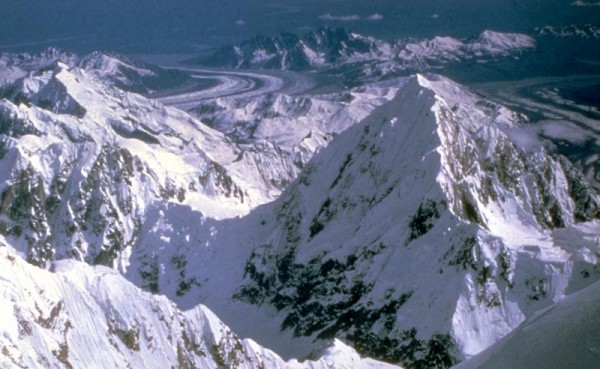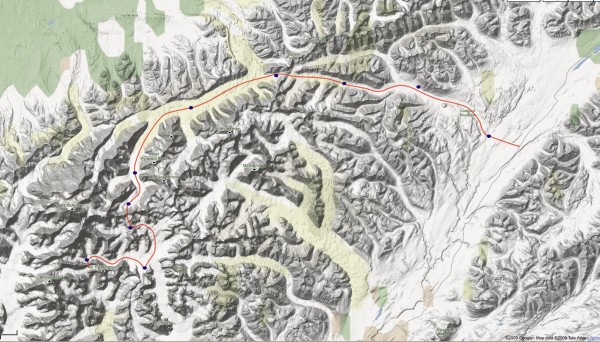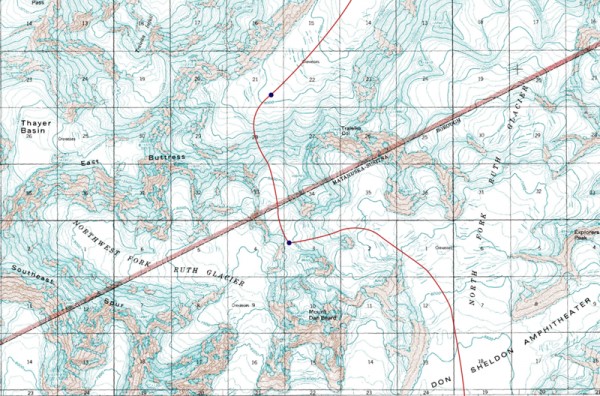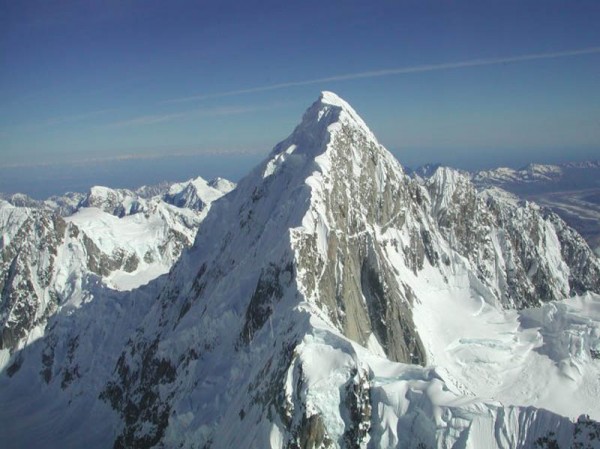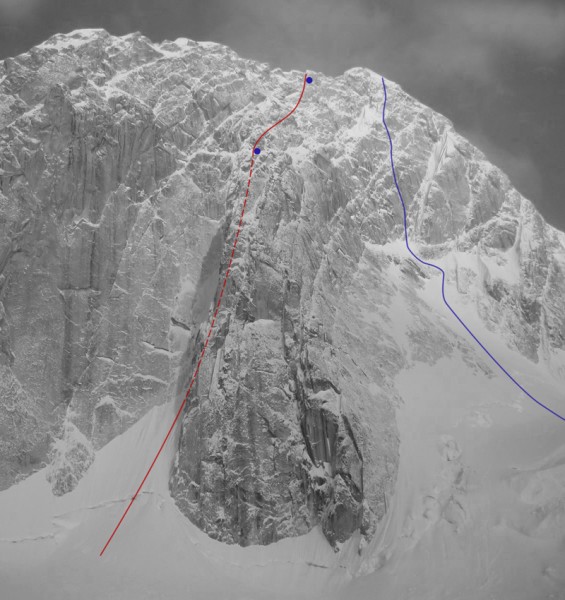In March, 1983 Keith Royster (Keithís last name is now Stevens) and I set off on our first two-man expedition into the Alaska Range. All of our previous trips had been with a minimum of four climbers, although we had always climbed as two-man rope teams. For this new foray into the range we decided to raise the ante a bit by resetting some of the parameters.
First, just the two of us. That cuts the margin of error for the expedition in half. In the event of an accident that injures one climber, it is much harder to affect a rescue, and too dangerous if not impossible to go looking for help. The tragic experiences of Jim Wickwire and Chris Kerrebrock on the Peters glacier just two years before come to mind (read Jim's book Addicted to Danger: A Memoir about Affirming Life in the Face of Death).
Second, a longer approach. In previous expeditions, we had skied into the Ruth from the Alaska railroad up the Buckskin Glacier, which is the shortest, most direct line into the Don Sheldon Amphitheater. This time we would use a new route, skiing from the Anchorage/Fairbanks highway up the Chulitna River to the West Fork glacier, cross Anderson Pass onto the Muldrow Glacier on the North side of the range, and finally cross back into the Ruth from the head of the Traleika glacier. This is a distance of around 100 miles.
Third, travel light and fast. For the approach we would limit our climbing gear to the barest minimum; one 60-meter 9mm rope, double three-pin cross-country boots with overboots, flexible crampons, one ice tool each, and a few slings and biners. We would improvise anchors by using ice bollards and deadmen made from buried skis.
Forth, minimize contact with our air support. Our climbing gear and supplies would be pre-cached ahead of us at two places; In the Don Sheldon Amphitheater for an attempt on Mt. Huntingtonís West face, and on the Kahiltna glacier for a climb on Mt. Hunterís North Buttress.
Our one concession to our minimalist approach was a CB radio for contacting overhead aircraft in case of emergency.
So the plan in a nutshell was; ski in to the West Fork of the Ruth Glacier from the North side of the Alaska Range, climb Mt. Huntington, ski and climb over the South Buttress of Denali into the Kahiltna Glacier, climb Mt Hunter, and then ski out of the range to the South. Keep it simple.
We left the highway on March 13th in perfect weather, cold, clear and sunny. From the small village of Colorado, we crossed the Chulitna River, still well frozen and covered in deep snow. We made good time by following a snow machine track up the West Fork of the Chulitna, heading for the West Fork Glacier. About noon of the second day a hunter on a snow machine came roaring up and offered us a 3-mile ride in the sled he was pulling.
Later the same day we ran into a pair of Park Rangers and their dog team, heading back to the highway. They had been investigating an illegal cabin that had been built on National Park land at Ruby Creek, and told us to follow their tracks to the cabin if we wanted a warm night inside. They also said that as far as they knew, we were the only climbing party anywhere in the park at that time. The cabin was just what you would expect an Alaskan trappers cabin to be like; a low log structure set back in the trees, with a cast iron stove, a pair of bunks, a stockpile of firewood and canned food, and a rifle hanging from pegs on the wall.
We spent another two days gaining Anderson Pass. We crossed the divide and descended onto the storied Muldrow Glacier, the approach route of the pioneer expeditions to Denali. Conditions changed dramatically, from deep powder snow on the South side of the range, to a windswept, rock hard frozen surface strewn with rocks of all sizes, fine gravels to giant boulders. The Muldrow is two mile wide and broken with pressure ridges and medial moraines. It was 20 miles to the junction with the Traleika Glacier, and we carried our skis the entire way, staying up on a pressure ridge so we could see the best path through the tortured ice and debris.
Once on the Traleika the snow conditions improved and we could ski again. It was another 12 miles to the head of the Traleika. To our right were Mounts Carpe and Koven. To our left Mt. Brooks, the Pyramids, and Mt. Silverthrone. Our first camp on the Traleika was at the junction with the West Fork of the glacier, and from there we could look up the West Fork to Karstenís Ridge and Browne Tower, the route of the first ascent of Denali.
The next day we pushed on up the Traleika to its headwall, where the East Buttress of Denali, descending from Thayer Basin, blocks access to the Ruth just beyond. We set our final north-side camp at 7800 feet. Ahead of us was a wall of ice and snow rising to a pass at 10,500 feet. This was definitely the most remote place Keith and I had ever been, seven long days of skiing from the nearest road, barren, windswept, and silent but for the wind and sounds of moving ice.
Galen Rowellís party first used this route as a pass from North to South in 1978 during their circumnavigation of Denali. Scott Woolums and I had watched them descending from the pass that year from high on Mt. Dan Beard, which sits just south of the pass. They had done multiple rappels from ice screws on the descent to the Ruth. Keith and I would have to down climb. We werenít carrying any screws.
The next morningís work began before dawn. The climb to the top of the ridge was straightforward, although ice climbing in our soft three-pin double ski boots left something to be desired. It took us six hours to climb to the ridge top. The view from the ridge top was beyond description, the bulk of Denali to the west, Mt. Dan Beard immediately to the south, the deep gorge of the Northwest Fork of the Ruth down below, with the Southeast Spur of Denali beyond.
Now things would get interesting. We immediately began down climbing, swinging 60 meter leads between belay anchors set in the deep snow using a set of skis as pickets/deadmen. Ten rope lengths brought us to the top of an obvious drop-off. We couldnít see how big a drop it was, so we set up a rappel to find out. We chopped out a big ice bollard and ran the rope around it. I down climbed until I could get attached to the line, then lowered about 50 feet and looked over the edge.
It was one of those good news/bad news situation. Good that we somehow managed to hit the bergschrund at itís narrowest spot. Bad that the rope ended about 15 feet short of the bottom. The huge crevasse below the end of the rope was filled with snow. It LOOKED like it was pretty solidly filled. I looked up at Keith and said, ďIím going to drop off the end of the rappel. Clip the line into your belay so I donít pull the rope down. You might need itĒ. I donít think he was happy about the plan.
I dropped over the lip and was hanging free. Lowering to the bitter end of the rope, I untied the safety knots at the end (kids, donít try this at home!) and tried to let them both come through my figure eight together. A second later I landed in the Ďschrund, unhurt, in deep snow. When a reluctant and slightly pissed off Keith appeared at the lip, I told him to pull up one end and tie in to it so we wouldnít loose the rope when he dropped off the end. After a few choice words from my partner, he arrived at the bottom, none the worse for wear.
After dusting ourselves off we descended another few hundred feet to a saddle at 8500 feet and made camp. Beyond the saddle to the south the way was blocked by 10,250 foot Mt. Dan Beard. To the west an icefall dropped steeply into the heavily crevassed Northwest Fork of the Ruth. Our route lay to the east, where another icefall fell 1500 feet into the North Fork, and an easy 7-mile ski to our cache on the south side of the amphitheater.
The snow was once again thigh-deep powder, and climbing down the icefall would not be easy going. Without our skis to distribute our weight we stood a good chance of finding a very deep hole, and we didnít have a lot of resources for a crevasse rescue. So we pushed off the top on skis, climbing skins attached to slow the descent a bit, and roped together for safety.
Skiing roped up with heavy packs is tricky even on easy slopes. Doing it in a maze of massive seracs and crevasses that drops 1500 feet in a half mile is a real challenge. Many times the leader would feel the snow collapse under his ski tails when crossing an obvious crack. Keeping the speed up was the key to avoid falling in. The leader would shout a warning, and the follower would bank his turn a bit wider to avoid the hole. Eventually we skied out onto the lower angled glacier below the icefall.
Six hours after leaving the top of the icefall the long slog across the Don Sheldon Amphitheater was behind us. The first part of the long approach to Mt. Huntington was complete. We dug out the snow blocking the door to the small octagonal cabin known as the Mountain House and moved in. This spot is the primary landing strip for parties flying into the Ruth, and I had spent many days there over the past several years. From this spot we had launched ascents of Mt. Dan Beard, The Mooseís Tooth, The Rooster Comb and Mt. Dickey.
On this occasion it was just a waypoint, a supply depot where we would gear up for the climb and pick up food and fuel for ten days. The cache we had expected wasnít there, but the next morning Jay Hudson landed with our food and gear, and a surprise delivery of a six-pack of PBR and a couple of choice t-bone steaks.
The next day as we relaxed and prepared our gear I made a discovery that would later have serious consequences. I was adjusting my rigid crampons to fit the soles of my borrowed pair of brand new plastic climbing boots. This was new technology in 1983, and the plastics were a third the weight of my heavy leather double boots. I adjusted the left crampon to fit the boot sole, and mirror-imaged the right crampon. When I fit it to the sole of the right boot, it was a half-inch too long. I double-checked the adjustment; it matched the left crampon exactly. I checked the boots; left boot size 10, right bootÖ shit! Size 9! My borrowed boots were mismatched and the right boot was one size too small.
There was no way I was going to let this end our expedition. I hadnít even noticed the difference when I tried on the boots back in Portland. Now I would just wear a thinner sock on the right. It would be fine. The next morning we packed up and began the 7-mile ski up into the West Fork.
I never tired of the ski tour from the amphitheater up into the West Fork. Turning the corner of the Rooster Comb and coming into view of the awe inspiring North Face of Mt. Huntington stuns you every time. You donít have to get lucky to see a dramatic avalanche come thundering down from Huntington or Rooster Comb. They are almost hourly occurrences, often sweeping right across your ski tracks. The West Fork is a deep, cold, ice-filled trench with walls a mile high.
Keith and I skied past our normal campsite at 7000 feet, and continued on to set our camp below the French Icefall. We would leave the tent, skis and a cache of 4 days of food and fuel here on the Ruth. Early the next morning we post-holed over to the base of the icefall and started climbing. I had been up this slope before on a failed attempt on the French Ridge, and knew it was pretty straightforward. Nick and Tim had said the descent to the Tokositna was easy, and so it was. We rappelled and down climbed to the glacier and had plenty of time to dig a nice cave and settle in for the night.
The next day was a rest and recon day, and we watched the face for avalanche activity and talked about options for the descent down the Harvard Route, or maybe just to its north side. We looked at the sweeping 2000-foot couloir of our route and the 2000 feet of mixed climbing above that and thought that those brits had a pretty good eye for a line. The route looked to be in great condition, and after watching all day not a single thing had fallen of the face.
On the 15th day after skiing off from the highway we climbed up the broad base of the funnel-shaped couloir, swinging long leads of simul-climbing on perfect ice. The weather was settled and clear, but cold, at about -10. As we gained height the angle steadily steepened, and snow turned to solid blue ice. The surface ice was rock hard and brittle, and every placement sent a shower of ice down the rope to pummel whichever of us was tied to the dull end.
The final lead of the day was mine, and I was getting flamed. My arms ached from being bombarded all day with falling ice, and the broad couloir had narrowed into a proper gully. The final 200 feet were nearing 85 degrees, and I slowed down, afraid of a fall as we climbed together up the steep ice. I climbed into a fluted chute and was able to rest in a wide full-body stem, then made a final slow-motion charge over the top to find a roomy ledge that would make an adequate bivouac. I slammed in an anchor and brought Keith up, thanking him for his patience at the slow pace of those last few feet.
The open bivy was comfortable but the night was very cold, with the temperature dropping below -20. We both slept boots on, in sleeping bag and bivy sac, and awoke to another day of perfect clear weather. After a quick brew we set off on the best day of mixed climbing of our lives. Never desperate, but continuously steep and interesting, the climbing was amazing. The sun and views made the belays enjoyable in spite of the cold.
The sun was setting as I set up a semi-hanging stance about 100 feet below a snow ledge that we had been aiming for all day. I chopped a boot ledge in the ice and brought Keith up. Keith was pretty tired as he arrived at the stance, and since I was rested I volunteered to lead on up to the ledge, where it looked like we could spend the night. I should have grabbed my headlamp before I left the tiny stance, but I thought the light would last long enough.
With speed in mind, I ran out a quick 50 feet on steep verglassed rock, and hung a sling around a perfect granite horn. Protected, I climbed another 30 feet to the base of a steep slab split by a 3-inch runnel of ice. The ledge beckoned just beyond. I realized that it had become much darker when my first tool placement threw sparks into the gathering gloom. I tried a dozen more times to get a pick into the thin ice, rewarded with nothing but more sparks.
To my left the rock disappeared under a near vertical snow slab that led to the same ledge. I traversed over and the snow seemed firm, so I started double-shafting my way up. Twenty feet and Iíd have it made. My head came over the top and I heaved a sigh of relief, reaching over the edge to shove my ice ax shaft into the snow. It felt like stabbing into spun sugar, there was no resistance at all, and no purchase for mantling up off of the vertical wall.
I poked around with my axe, but there was nothing to offer the slightest hold. Then I felt my north wall hammer, still driven in to the head just below the lip, start to break out. My footholds began disintegrating under my weight and suddenly I was airborne as the snow collapsed beneath me. I felt myself contact the wall again and again as I pin wheeled down in the darkness into a vertical mile of air.
Keith looked up at my yelp of surprise, and saw only bursts of sparks as my ice tools and crampons struck granite. I fell past his belay to the right and jerked to a stop ten feet below. My single piece of protection, the slung horn, had probably just saved both our lives. Within seconds I realized that, though shaken, I was not hurt. My tools still hung by the wrist loops, my right crampon was hanging from itís ankle strap, bent nearly double, and my helmet was gone, but I was alive and uninjured after the 100 foot fall.
With tension from Keith, I struggled back up to the tiny stance and took stock. Now fully dark, with my gear and brain in disarray, it was obvious that we would have to spend the night right where we were. As I hung from the anchor collecting myself, Keith began a 2-hour effort to enlarge the foot ledge to something that we could sit on. It was midnight before we were sitting/hanging in our bags, backs against the wall and the stove between us on the now 12-inch wide ledge.
Somehow we managed to sleep through the coldest night yet. At one point I woke up and glanced over at Keith and my heart stopped. He was gone! Well, not gone, just sound asleep and doubled over at the waist, hanging from the anchor. Later, in the morning light, I bent my crampon back into something that would fit loosely onto my boot, and told Keith that it was still my lead.
I backed up the sling on that beautiful horn as I climbed past. At the bottom of the ice runnel that had frustrated me the night before, I excavated a bombproof placement. In the light of day I could see where the thin ice offered sketchy tool placements, and surged safely up to the ledge in a matter of seconds. A few easy leads later and we were on the summit snowfield.
We held a quick conference and decided to forego the summit. We were just above the top of the Harvard Route, low on food and fuel, and had a long way to go to get back to our camp on the Ruth. Down climbing, we got to the top of the vertical headwall pitch on the Harvard Route, and began a series of rappels to the right, down a steep little gully. Natural anchors were plentiful, and we left mostly slings as we descended rapidly back to the glacier. Just below the Ďschrund I picked up my helmet, none the worse for its 4000-foot fall.
Crossing the ridge on our way back to the Ruth, we unroped about halfway down the French Icefall. Our tent out on the Ruth was looking really good, and we were in a hurry to get down. My right crampon was pretty useless, and had been coming off my boot every so often since the fall. 200 feet from the bottom of the icefall it decided to fall off one more time. I was on a bulge of good looking blue ice at the time, so I slammed both tools into the ice and clipped into them with my daisy chain.
I bent over and began working on the bent-up crampon, putting weight on my tools. I heard a noise like when you pour a drink over really cold ice-cubes, and my tools fell past me, attached to 18-inch dinner plates of hard Alaskan ice. I was jerked of my feet, and accelerated down the slope toward a 50-foot cliff. I shot over the lip and landed in a pile of avalanche debris at the bottom. My luck was now played out, and my right fibula snapped.
Keith walked over, shaking his head. He gave me a couple of Percodan and splinted the leg. I tried to stand, but couldnít bear any weight, so I crawled the half-mile to the tent, dragging the leg behind. By this time the drugs were kicking in and I told Keith that I thought maybe it was just a bad sprain, and I thought Iíd be able to travel in a couple days. He laughed and gave me more drugs. Keith helped me get into the tent and get my boots and clothes off to examine the leg. As he pulled off my right sock, he took a long look at my foot and said, ďJay, your toes are frozen.Ē
We spent the next several days watching our food and fuel supplies diminish, hoping for the sound of a plane. I kept the radio inside my bag to keep the batteries warm, and my toes outside the bag to keep them frozen. We didnít know how long Iíd be there, and I didnít want to risk infection by re-warming my foot. Our last resort was for Keith to ski back down to the amphitheater, where it was much more likely to find help. But that meant a 7-mile solo over some of the biggest crevasses in the Range, not something I wanted him to risk.
We were burning the last of our fuel to make a final hot brew when we heard the beautiful sound of a Cessna coming over Ruth Gap. I had the radio out in an instant, and Jay Hudsonís voice filled the tent. We told him our situation, and he asked if we were still trying to minimize our air support, or were we ready for a ride.
Keith described the glacier below our camp. There were several depressions marking large crevasses on the slope. Maybe, he suggested, we should travel down glacier to the regular airstrip at 7000 feet. Jay replied with the news that a 4-day storm was hours away, and he would be right down, so we should start packing.
Jay kept the power on as he flew the Cessna up the slope, flying right across the low spots. He kicked the plane sideways not 20 feet from the tent. Three hours later I checked in to the hospital. Mt. Hunter was going to have to wait.
